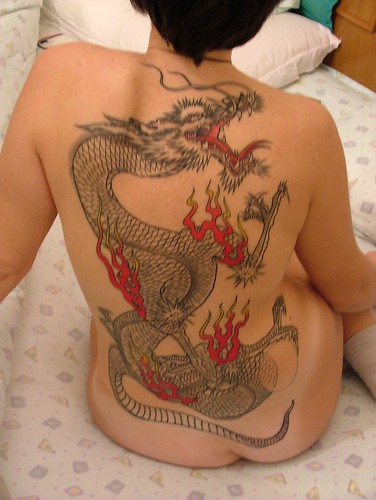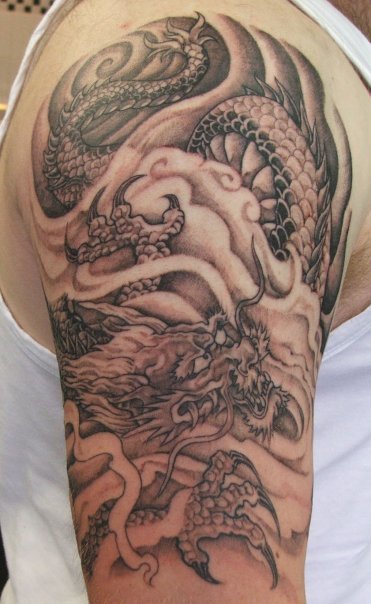 The Chinese dragon is said to have the head of a camel, the horns of a deer, the eyes of a rabbit, the ears of a cow, the neck of a snake, the belly of a fog , the scales of a carp ,the claws of a hawk, and the palm of a tiger .it has whiskers and a beard, and it is deaf. Chinese Dragon is generally regarded as benevolent but is also the source of thunder and lightning.
The Chinese dragon is said to have the head of a camel, the horns of a deer, the eyes of a rabbit, the ears of a cow, the neck of a snake, the belly of a fog , the scales of a carp ,the claws of a hawk, and the palm of a tiger .it has whiskers and a beard, and it is deaf. Chinese Dragon is generally regarded as benevolent but is also the source of thunder and lightning.As a matter of fact, Chinese dragons are the creation of Chinese ancestors' imagination. Therefore, if you ask 10 people what they look like, most probably you'll get 10 different answers. So what they look like is of little significance, what is important is that they are now a kind of cultural phenomenon.

It has become a spiritual tie linking the nation. So we can say, Chinese dragon, as the symbol of the Chinese nation, has become part of the Chinese people. They have deep feelings for Chinese dragon and are proud to call themselves the offspring of Chinese dragon.
China is the birthplace of dragon culture. This has been shown by relics of the Neolithic age discovered in the Yellow river, Yangtze River and Liaohe river basins. The first discovery occurred in Chifeng in Mongolia, and in Yulong, in northeast China's Liaoning province. Archaeologists found dragons depicted on pottery. This gave rise to serious study of Chinese dragon culture. Dragons from the Liaohe river basin have the head of a pig and body of a snake, but no horns. They are a typical dragon pattern with local variations. They reveal the origin on the Chinese dragon culture.

Archaeologists predicted that in the Yellow river basin where primitive culture started, they would eventually find the original Chinese dragon culture. Three years later, in the autumn of 1987, three sets of dragon patterns were discovered in central China's Henan province. one of the Chinese dragons was 1.78 meters long with its head to the north and back to the west. shells were used to shape its teeth and hair, giving a vivid three-dimensional image similar to the Chinese dragon described in legends. The three dragon patterns belong to the Neolithic period and have a history of more than 6000 years. They are the earliest and most vivid patterns yet discovered in china.
Tuyang county, where the dragons were discovered, is located in the lower reaches of the Yellow river. It's the cradle of ancient Chinese civilization and the place where the legendary ancestor fuxi lived. The discovery of dragon patterns in the region has provided important materials in studying the origin of Chinese dragon culture.
In June 1993, a giant dragon pattern made with cobbles was found in central china's Hubei province. it was also formed in the Neolithic period. It's four and a half meters long, with its head to the west and tail to the east. on the head, there's a horn .its mouth is wide open and its long tongue rolls up to the head, it has two claw-shaped feet, and its tail is turned upward. The different colored cobbles are built into the pattern, which looks as though it's flying. The dragon was first found in the Yanghe river basin. Its discovery shows that like the yellow river basin, the yanghe basin was also a birthplace of the dragon culture. It also shows that Chinese ancestor's worship of dragon dates back to early primitive times.
Chinese people claim to be the offspring of the dragon on the basis of the legendary figure, Fuxi. Fuxi is generally acknowledged as the earliest ancestor of Chinese nation. He's said to have had a human head, and the body of a dragon. he lived in northwestern china's Gansu province. later, he led his tribe down the Yellow river and settled in central china. He created weaving and musical instrument skills. Even the eight diagrams are said to have been worked out by him.
Years after his death, a magnificent tomb and temple were built in his honor in his burial place, today's Huaiyang County. From this story, Huaiying get the name dragon city . today, on the second day of February in the lunar calendar, thousands of people will go to Huaiying to worship Fuxi, because Chinese dragon is said to awaken and hold up its head, and this will be the start of the rainy season. People hope to be protected by the spirit of Chinese dragon.
 This is a tattoo of the china is very interesting to follow our progress, at the modern tattoo of this china is no less competitive than the tattoo-tattoo because the previous development of the tattoo bamboo curtains in the country is quite a rapid development, if you want to see tattoo and make models of the Chine you can see this my blog the happy...
This is a tattoo of the china is very interesting to follow our progress, at the modern tattoo of this china is no less competitive than the tattoo-tattoo because the previous development of the tattoo bamboo curtains in the country is quite a rapid development, if you want to see tattoo and make models of the Chine you can see this my blog the happy...

